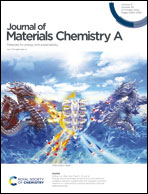High-sensitivity CdTe phototransistors with the response spectrum extended to 1.65 μm†
Abstract
CdTe, widely used in radiation detectors, optoelectronics and photovoltaics, is a typical II–VI semiconductor with covalent and ionic bonds where various defects are easily induced and their physical properties are well documented. However, development of electronic and photoelectronic devices with deep defect states is still absent. Here, CdTe thin films with diverse defect levels are purposely grown through a van der Waals epitaxy (vdWE) mode by molecular beam epitaxy. A water-assisted method is developed to exfoliate and transfer the vdWE CdTe to fabricate field effect phototransistors. Large-area CdTe thin films of hundreds of microns and with a well-defined crystalline structure can be transferred. The on/off ratio of 39 and mobility of 0.02 cm2 V−1 s−1 reach optimal values in the achieved CdTe. Besides the improved sensitivity by gate modulation, for the first time, the spectral response region can be extended to 1.65 μm far beyond the cutoff wavelength of 870 nm. In the whole extended region, ultrahigh responsivity and detectivity above 3.84 A W−1 and 3.73 × 1011 Jones, respectively, are yielded, which are comparable or superior to those of Si, Ge, GaP and InGaAs photodetectors. These outstanding electrical and optoelectronic properties illustrate a strong competitiveness with these commercial detectors. A possible mechanism of the spectrum expansion by a gate is detailed and attributed to the photogating dominated response under an external field.



 Please wait while we load your content...
Please wait while we load your content...